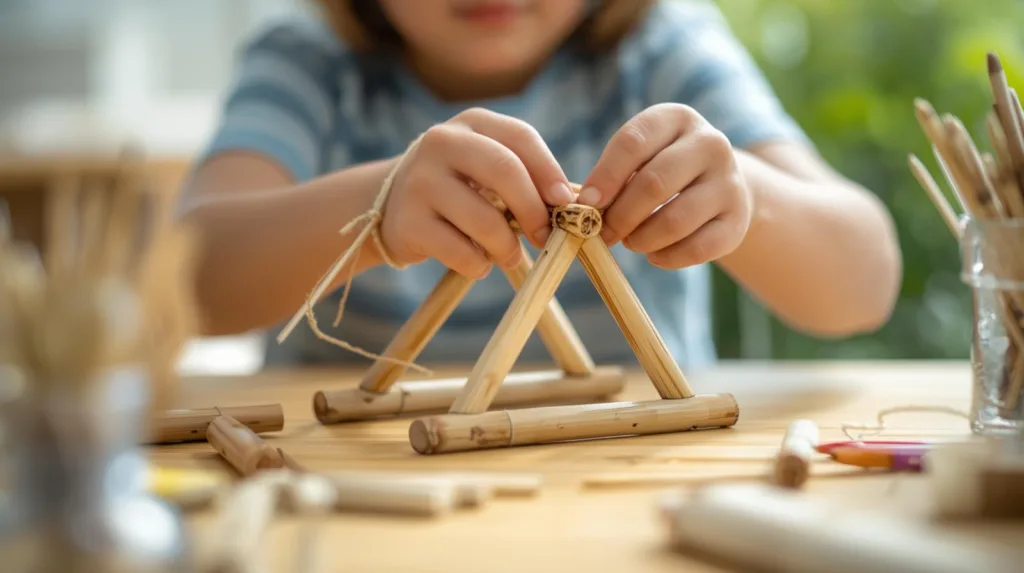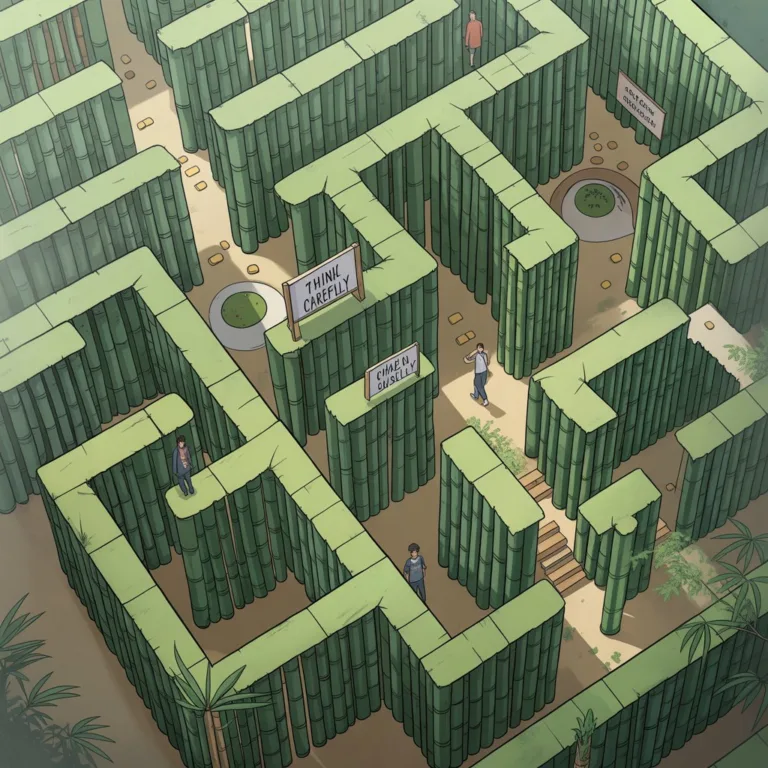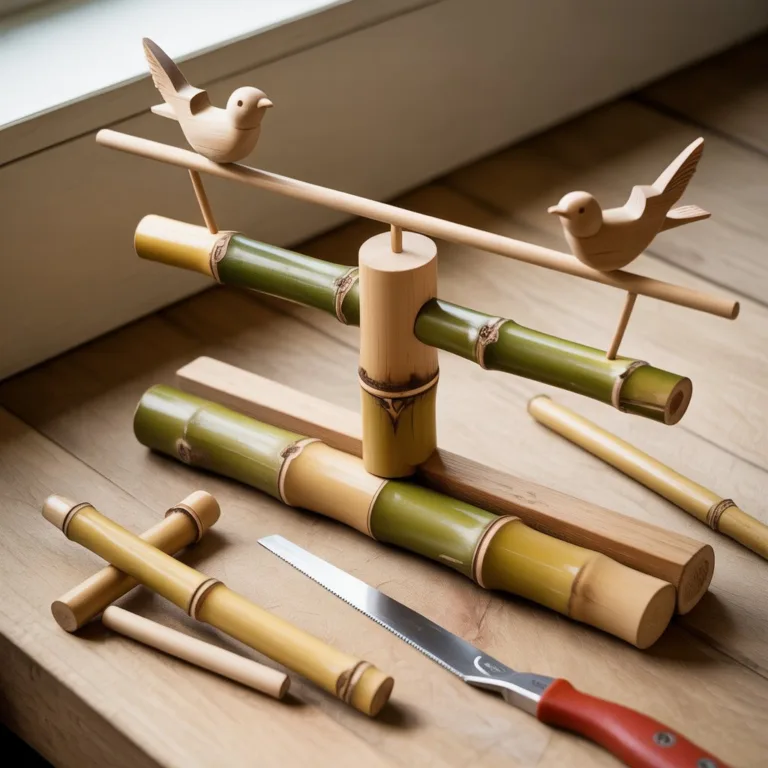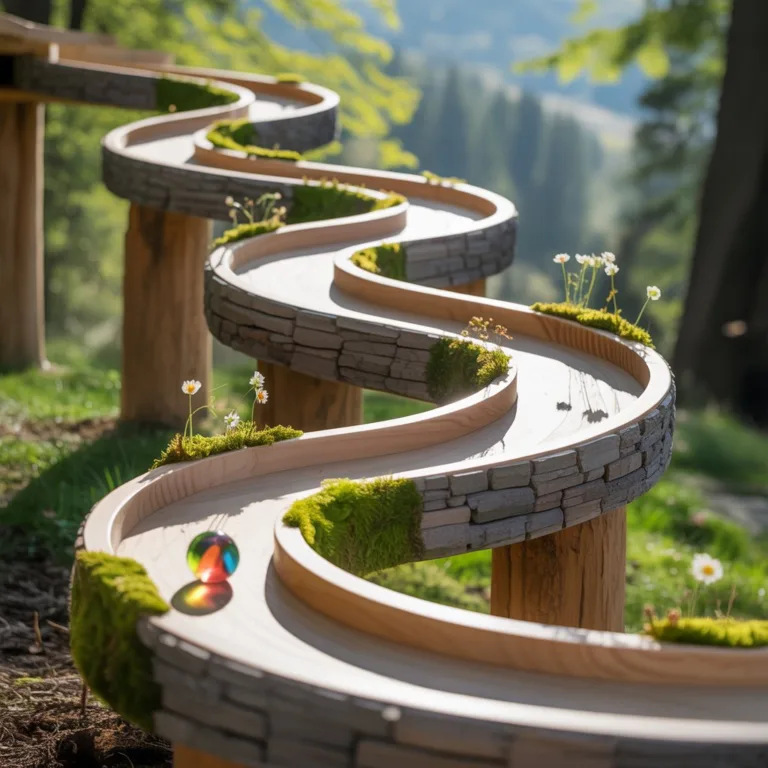Building a bamboo catapult is one of those creative, educational projects that perfectly combine fun, science, and sustainability. It allows children to explore physics, engineering, and problem-solving through hands-on play. Using bamboo as the main material makes the project eco-friendly, durable, and naturally beautiful. This activity also teaches kids about reusing natural materials responsibly while ensuring their safety throughout the process.

Creating a bamboo catapult safely for kids doesn’t have to be complicated. With some simple materials, clear safety guidelines, and adult supervision, you can make a functional mini catapult that launches small, soft objects — all while teaching the principles of tension, force, and motion.
Why Bamboo Is the Perfect Material
Bamboo is one of the most sustainable building materials on the planet. It grows rapidly, requires no replanting after harvest, and is lightweight yet incredibly strong. For DIY projects like a catapult, bamboo offers the perfect balance between strength and flexibility.
Other reasons bamboo works so well include:
- Eco-friendliness: Bamboo regenerates quickly, reducing environmental impact compared to plastic or wood.
- Safety: It’s smooth, non-toxic, and easy to handle when properly sanded.
- Educational value: Working with bamboo helps children understand natural materials and sustainability.
- Versatility: Bamboo can be cut, tied, and assembled easily using basic tools.
When handled carefully, bamboo offers a natural way for kids to engage with crafting and science without relying on synthetic materials.
Understanding the Science Behind a Catapult
Before building, it’s helpful to understand what makes a catapult work. A catapult stores potential energy — usually in a stretched band, a bent stick, or a flexible joint — and converts it into kinetic energy when released. This energy transfer launches the projectile forward.
Key principles children can learn through this project:
- Tension and elasticity: Elastic bands or cords store energy.
- Leverage: The catapult arm acts as a lever that multiplies force.
- Projectile motion: Gravity and angle affect how far and high the object travels.
- Balance and stability: The base needs to be sturdy to handle repeated launches.
This transforms the project from a simple toy into a hands-on science experiment that sparks curiosity and understanding.
Materials You’ll Need
You don’t need fancy tools or materials to build a bamboo catapult. Most items can be found at home or in nature.
Eco-friendly materials:
- 4–5 bamboo sticks (around 20–30 cm long)
- Natural rubber bands or recycled elastic bands
- Twine or jute string
- A small piece of recycled cardboard or a bottle cap (for the projectile holder)
- Sandpaper (to smooth bamboo edges)
- Soft projectiles (cotton balls, paper balls, or small cork pieces)
Optional safety equipment:
- Gloves for children handling bamboo
- Safety glasses during testing
- A flat, open space for launching
All materials should be lightweight, safe, and non-toxic. Avoid using sharp bamboo edges or any projectiles that could hurt someone.
Preparing the Bamboo
Start by cleaning the bamboo pieces and checking for splinters or cracks. Smooth rough edges with sandpaper. This step is essential because raw bamboo can have small fibers that cause irritation. Once the pieces are smooth, you can cut or break them to size.
Choose one thicker piece for the catapult base and two smaller ones for the upright supports. The remaining sticks will form the throwing arm and stabilizing crossbars.
Building the Base
The base of your catapult determines how stable the entire structure will be. It should be wide enough to support the tension of the throwing arm.
- Lay two bamboo sticks parallel to each other.
- Tie the ends together with twine or elastic bands to form a rectangle or square.
- Add a crossbar diagonally for extra stability if needed.
This forms a strong foundation that keeps the catapult from tipping during use.
Attaching the Upright Supports
The vertical supports hold the throwing arm in place and allow it to swing freely.
- Position two bamboo sticks upright at one end of the base.
- Secure them using string or rubber bands.
- Make sure they are evenly spaced and standing straight.
The distance between them should allow enough room for the arm to move without friction.
Creating the Throwing Arm
The throwing arm is where the magic happens. It’s responsible for storing and releasing energy.
- Take a single bamboo stick — ideally flexible but strong.
- Attach one end between the two vertical supports using rubber bands. This point will act as a hinge.
- On the free end, glue or tie a bottle cap or small cardboard cup to hold the projectile.
The arm should swing smoothly and easily when pulled back.
Adding the Launching Mechanism
There are several safe and fun ways to create the tension that launches the projectile:
- Rubber band method: Tie a rubber band between the vertical supports and hook it to the throwing arm.
- String tension: Use a twisted string that stores energy when pulled.
- Lever pull: Attach an elastic cord from the arm to the base for a spring-like effect.
Each method demonstrates how stored energy turns into motion. Kids can experiment with different elastic materials to see which one provides the best launch distance.
Testing the Catapult Safely
Now comes the exciting part — testing! But before launching anything, make sure all participants understand the safety rules.
Safety guidelines:
- Always aim away from people and fragile objects.
- Use only soft projectiles like cotton balls or paper balls.
- Launch in an open area or outside where there’s plenty of space.
- Check the structure before each use to ensure it’s stable and secure.
Once ready, load a soft projectile into the holder, pull back the arm gently, and release. Observe how far it travels, and encourage kids to note what happens when they change the launch angle or tension.
Turning It into a Learning Experiment
A bamboo catapult isn’t just a toy — it’s a fun science lab disguised as playtime. Encourage children to record their observations in a small notebook:
- How far does each type of projectile travel?
- What happens when they change the arm length or launch angle?
- Which materials provide the strongest elastic force?
These questions stimulate critical thinking and turn play into hands-on learning. You can even introduce basic STEM vocabulary like “trajectory,” “force,” and “elasticity.”
Decorating the Catapult
Once the structure works, it’s time to make it look amazing! Let children decorate their catapults with paint, natural dyes, or markers. Use eco-friendly paints made from vegetable pigments or water-based colors. You can also wrap the bamboo sticks with colored jute twine or paper strips for a rustic finish.
Decorating transforms the project from a simple mechanical toy into a personal creative expression, giving kids a sense of pride in their creation.
Teaching Environmental Awareness Through Crafting
This project is more than just fun — it’s a great opportunity to teach sustainability. By using bamboo and recycled materials, you’re showing kids that they can build amazing things without relying on plastic or wasteful products.
You can expand the learning by discussing topics like:
- How bamboo grows and renews itself faster than trees
- The importance of using natural, biodegradable materials
- How reusing items reduces environmental waste
Children learn that every creative project can also be a small act of environmental care.
Encouraging Collaboration and Problem Solving
Working together to design and build a catapult helps develop teamwork, patience, and problem-solving skills. Let children brainstorm improvements or alternative designs — maybe adding more bamboo supports or experimenting with double arms. This flexibility encourages creative engineering thinking.
When a group builds together, they also learn communication and cooperation — essential life skills that extend far beyond crafting.
Safety Maintenance and Long-Term Use
Even after building, regular maintenance helps keep the catapult safe and functional:
- Check for loose ties or cracks in the bamboo before each use.
- Replace worn elastic bands to prevent snapping.
- Store the catapult in a dry place to avoid bamboo weakening.
Since bamboo is a natural material, it’s biodegradable and safe to compost once it’s no longer usable. This makes the project fully eco-friendly from start to finish.
Expanding the Project for Older Kids
For older children or teens, you can make the project more advanced by introducing measurement and precision:
- Experiment with different lengths of bamboo arms to test how leverage changes.
- Measure launch distance at different angles (30°, 45°, 60°).
- Record data and make graphs showing the relationship between angle and distance.
This turns the craft into a real scientific study — blending creativity, engineering, and analytical thinking.
The Joy of Sustainable Play
Building a bamboo catapult isn’t about making a weapon — it’s about curiosity, experimentation, and fun. It connects children to the physical world, encourages eco-friendly habits, and gives them confidence to build things with their own hands. Most importantly, it shows that learning doesn’t need to happen in a classroom — it can happen right in your backyard, powered by imagination and bamboo.
So gather your materials, set up a safe space, and enjoy the process. Watch kids’ faces light up as they launch their first paper ball into the air — proof that sustainability and creativity can make science come alive.

Elena Mora is a creative educator and eco-craft enthusiast who specializes in bamboo musical instruments and sustainable toys for children. She believes that hands-on learning through play teaches kids about creativity, music, and environmental responsibility.



